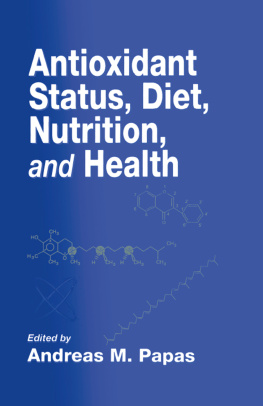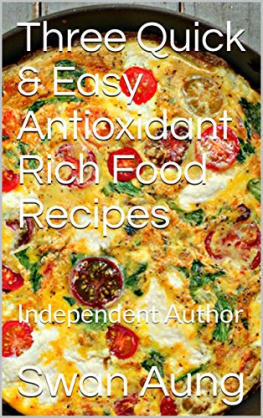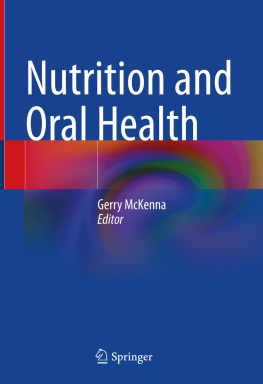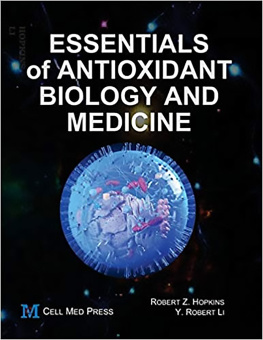Contents
Page List

CRC Series in
CONTEMPORARY FOOD SCIENCE
Fergus M. Clydesdale, Series Editor
University of Massachusetts, Amherst
Published Titles:
Americas Foods Health Messages and Claims: Scientific, Regulatory, and Legal Issues
James E. Tillotson
New Food Product Development: From Concept to Marketplace
Gordon W. Fuller
Food Properties Handbook
Shafiur Rahman
Aseptic Processing and Packaging of Foods: Food Industry Perspectives
Jarius David, V. R. Carlson, and Ralph Graves
The Food Chemistry Laboratory: A Manual for Experimental Foods, Dietetics, and Food Scientists
Connie Weaver
Handbook of Food Spoilage Yeasts
Tibor Deak and Larry R. Beauchat
Food Emulsions: Principles, Practice, and Techniques
David Julian McClements
Getting the Most Out of Your Consultant: A Guide to Selection Through Implementation
Gordon W. Fuller
Antioxidant Status, Diet, Nutrition, and Health
Andreas M. Papas
Forthcoming Titles:
Food Shelf Life Stability
N. A. Michael Eskin and Davis S. Robinson
Bread Staling
Pavinee Chinachoti and Yael Vodovotz
Antioxidant Status, Diet, Nutrition, and Health
Edited by
Andreas M. Papas, Ph.D.

CRC Press
Taylor & Francis Group
6000 Broken Sound Parkway NW, Suite 300
Boca Raton, FL 33487-2742
1999 by Taylor & Francis Group, LLC
CRC Press is an imprint of Taylor & Francis Group, an Informa business
No claim to original U.S. Government works
ISBN 13: 978-0-8493-8009-9 (hbk)
This book contains information obtained from authentic and highly regarded sources. Reasonable efforts have been made to publish reliable data and information, but the author and publisher cannot assume responsibility for the validity of all materials or the consequences of their use. The authors and publishers have attempted to trace the copyright holders of all material reproduced in this publication and apologize to copyright holders if permission to publish in this form has not been obtained. If any copyright material has not been acknowledged please write and let us know so we may rectify in any future reprint.
Except as permitted under U.S. Copyright Law, no part of this book may be reprinted, reproduced, transmitted, or utilized in any form by any electronic, mechanical, or other means, now known or hereafter invented, including photocopying, microfilming, and recording, or in any information storage or retrieval system, without written permission from the publishers.
For permission to photocopy or use material electronically from this work, please access www.copyright.com (http://www.copyright.com/) or contact the Copyright Clearance Center, Inc. (CCC), 222 Rosewood Drive, Danvers, MA 01923, 978-750-8400. CCC is a not-for-profit organization that provides licenses and registration for a variety of users. For organizations that have been granted a photocopy license by the CCC, a separate system of payment has been arranged.
Trademark Notice: Product or corporate names may be trademarks or registered trademarks, and are used only for identification and explanation without intent to infringe.
Visit the Taylor & Francis Web site at
http://www.taylorandfrancis.com
and the CRC Press Web site at
http://www.crcpress.com
Library of Congress Card Number 98-22208
Library of Congress Cataloging-in-Publication Data
Antioxidant status, diet, nutrition and health / editor, Andreas M.
Papas.
p. cm.
Includes index.
ISBN 0-8493-8009-X
1. AntioxidantsHealth aspects. 2. Free radicals (Chemistry)--Pathophysiology. 3. Nutrition. I. Papas, Andreas M.
RB170.A578 1998
Preface
We all know that diet is a major factor affecting human health, and the one single factor that would do much to decrease the incidence of cancer and cardiovascular disease is to encourage consumption of more fruits, grains and vegetables, even in smokers. It is also widely thought that antioxidants in these foods are responsible for some of the beneficial effects, which has led to aggressive marketing of antioxidant dietary supplements. The evidence is often hard to disentangle from the mass of literature.
This book is an attempt to summarize current knowledge of antioxidant status, diet, nutrition and health. Expert contributors take us effortlessly from the basic chemistry of free radicals and antioxidants through determinations of antioxidant status in humans and how this is affected by specific dietary habits. Each of the major types of antioxidant is carefully reviewed, but the up-and-coming agents such as phenolics are not neglected. The effects of antioxidants on a wide range of diseases are considered, including atherosclerosis, skin and colon cancer, eye disorders and neurological diseases. All the chapters carefully and authoritatively balance the evidence and illustrate the difficulties in distinguishing protective effects of diets rich in antioxidants from direct effects of the antioxidants themselves.
This is an excellent book and I recommend it to all who are interested in nutrition, as well as to the whole free radical/antioxidant research community.
Barry Halliwell, D.Sc., Professor
International Antioxidant Research Centre
Kings College, University of London
Foreword
Research on the role of antioxidants in human health and disease has advanced from basic metabolic and animal studies to major epidemiological investigations and intervention trials. The vast new knowledge has attracted the interest of the scientific community, but there is also strong public interest for the application of this knowledge in the fields of nutrition, medicine, and public health. To accomplish this, it is necessary to understand the effects of physiological, nutritional and clinical factors on the antioxidant status in humans, and the methods for evaluating it. The ways by which antioxidant compounds affect health status and disease processes need to be better understood. Last, it is essential to bring together the various fields that have contributed to the knowledge concerning antioxidants and their effects and to facilitate the interaction among the scientists who serve these diverse fields. This book represents an important contribution towards these objectives.
This book integrates the basic chemistry of free radicals and antioxidants with practical aspects of diet and nutrition, and evaluates their effects on antioxidant status, health, and disease. Prominent international experts, including biochemists, nutritionists and physicians, contribute to the integration of this very diverse knowledge. The multidisciplinary approach ensures a wide perspective on the status of our knowledge and a balanced discussion of the issues. Thus, it allows physicians and other health professionals to evaluate and apply the emerging knowledge about the role of antioxidants in nutrition, health, and disease.
This book should be useful to a wide range of readers, including students, researchers, physicians and other health professionals who are interested in antioxidants per se, as well as their role in physiological and pathological processes. It covers both theoretical and practical issues and addresses the needs of both the uninitiated and the sophisticated researcher. Antioxidants are likely to be critical in human physiology and pathology, and the reader of this book will be in a favorable position to understand the developments and apply the emerging knowledge in this important field.







